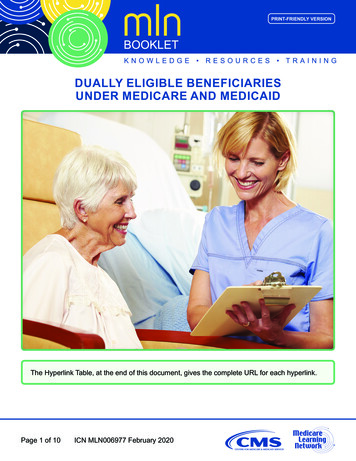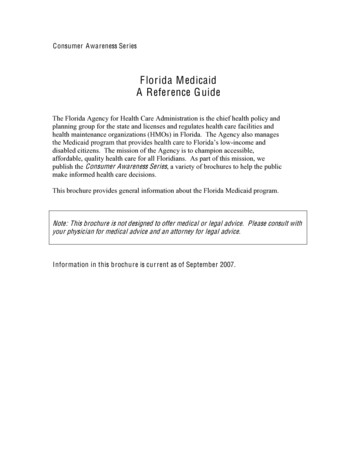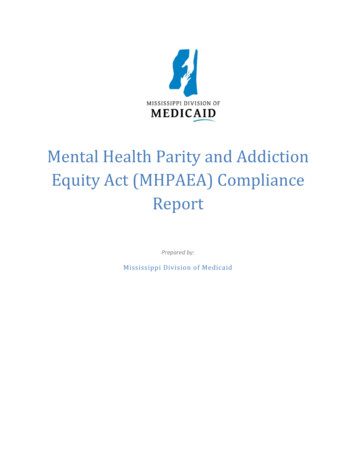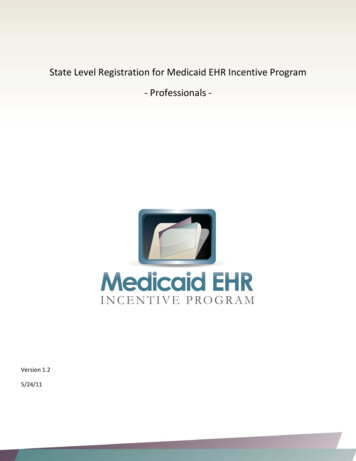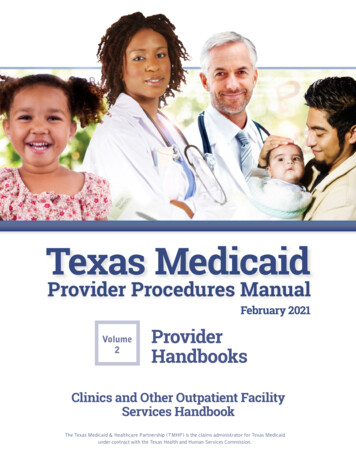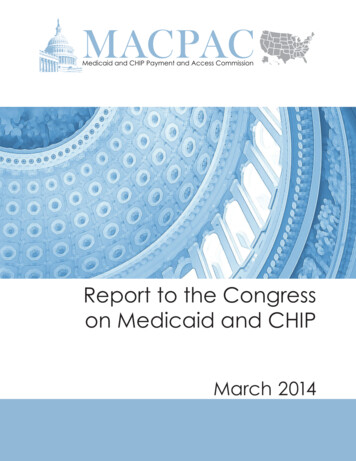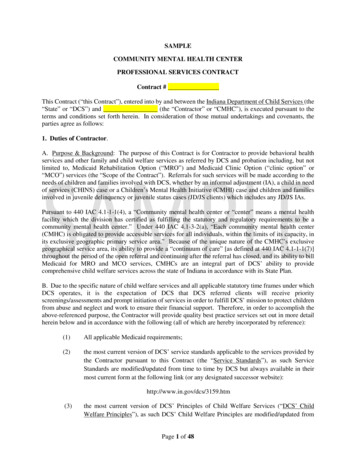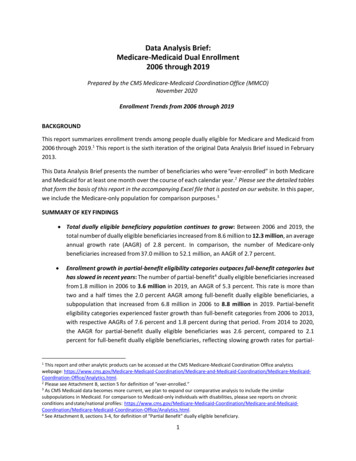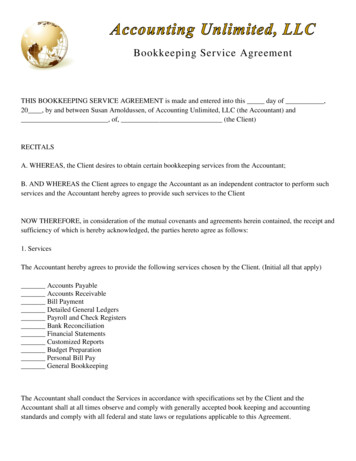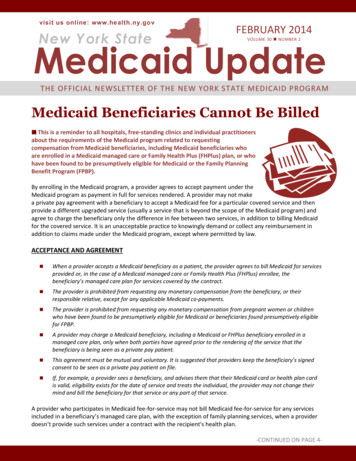
Transcription
visit us online: www.health.ny.govNew York StateFEBRUARY 2014VOLUME 30 NUMBER 2THE OFFICIAL NEWSLETTER OF THE NEW YORK STATE MEDICAID PROGRAMMedicaid Beneficiaries Cannot Be Billed This is a reminder to all hospitals, free-standing clinics and individual practitionersabout the requirements of the Medicaid program related to requestingcompensation from Medicaid beneficiaries, including Medicaid beneficiaries whoare enrolled in a Medicaid managed care or Family Health Plus (FHPlus) plan, or whohave been found to be presumptively eligible for Medicaid or the Family PlanningBenefit Program (FPBP).By enrolling in the Medicaid program, a provider agrees to accept payment under theMedicaid program as payment in full for services rendered. A provider may not makea private pay agreement with a beneficiary to accept a Medicaid fee for a particular covered service and thenprovide a different upgraded service (usually a service that is beyond the scope of the Medicaid program) andagree to charge the beneficiary only the difference in fee between two services, in addition to billing Medicaidfor the covered service. It is an unacceptable practice to knowingly demand or collect any reimbursement inaddition to claims made under the Medicaid program, except where permitted by law.ACCEPTANCE AND AGREEMENT When a provider accepts a Medicaid beneficiary as a patient, the provider agrees to bill Medicaid for servicesprovided or, in the case of a Medicaid managed care or Family Health Plus (FHPlus) enrollee, thebeneficiary’s managed care plan for services covered by the contract. The provider is prohibited from requesting any monetary compensation from the beneficiary, or theirresponsible relative, except for any applicable Medicaid co-payments. The provider is prohibited from requesting any monetary compensation from pregnant women or childrenwho have been found to be presumptively eligible for Medicaid or beneficiaries found presumptively eligiblefor FPBP. A provider may charge a Medicaid beneficiary, including a Medicaid or FHPlus beneficiary enrolled in amanaged care plan, only when both parties have agreed prior to the rendering of the service that thebeneficiary is being seen as a private pay patient. This agreement must be mutual and voluntary. It is suggested that providers keep the beneficiary’s signedconsent to be seen as a private pay patient on file. If, for example, a provider sees a beneficiary, and advises them that their Medicaid card or health plan cardis valid, eligibility exists for the date of service and treats the individual, the provider may not change theirmind and bill the beneficiary for that service or any part of that service.A provider who participates in Medicaid fee-for-service may not bill Medicaid fee-for-service for any servicesincluded in a beneficiary’s managed care plan, with the exception of family planning services, when a providerdoesn’t provide such services under a contract with the recipient's health plan.-CONTINUED ON PAGE 4-
Andrew M. CuomoGOVERNORState of New YorkIN THISISSUE Nirav R. Shah, M.D., M.P.HCOMMISSIONERNew York State DOHJason A. HelgersonMEDICAID DIRECTOROffice of Health Insurance ProgramsThe Medicaid Update is a monthly publication ofthe New York State Department of Health.FEBRUARY 2014 NEW YORK STATE MEDICAID UPDATEPOLICY AND BILLING GUIDANCEMedicaid Beneficiaries Cannot Be Billed . coverElectronic Health Records (EHR) Incentive Program Update . 2Nursing Home Population and Benefit Transition to Medicaid Managed Care . 6Billing for Clients enrolled with Medicaid Coverage: . 9Providers Urged to Submit Correct Coordination of Benefits (COB) Information to Medicaid . 10PHARMAC Y UDPATEMandatory Prospective Drug Utilization Review (Pro-DUR) . 11Update on Pharmacy Billing Procedures for Compounded Prescriptions . 13Medicaid Pharmacy Prior Authorization Programs Update . 14Coverage of Compounded Prescriptions for the Dual Eligible Population . 16Important Information on Ketamine use in Compounded Prescriptions. 16ALL PROVIDERSMedicaid and ICD-10 Implementation . 17Provider Directory. 19February 2014 New York State Medicaid Update2 P a g e
February 2014 New York State Medicaid Update3 P a g e
POLICY AND BILLING GUIDANCEA provider who does not participate in Medicaid fee-for-service, but who has a contract with one or moremanaged care plans to serve Medicaid managed care or FHPlus members, may not bill Medicaid fee-forservice for any services. Nor may any provider bill a beneficiary for services that are covered by thebeneficiary’s Medicaid managed care or FHPlus contract, unless there is prior agreement with thebeneficiary that they are being seen as a private pay patient as described previously. The provider mustinform the beneficiary that the services may be obtained at no cost from a provider that participates in thebeneficiary’s managed care plan.Note: Due to the requirement that PRIOR agreement be made for reimbursement, Medicaid beneficiariesmay never be charged for services rendered in an Emergency Room (except applicable Medicaid copayments).CLAIM SUBMISSIONProviders are strongly encouraged to confirm eligibility and the appropriate payor every time a patient isseen and before rendering services. Providers of long term services and supports are encouraged toconfirm eligibility on the 1st and 15th of each month, and, as applicable, promptly contact a recipient’snew managed care plan to ensure continued service authorization.The prohibition on charging a Medicaid or FHPlus recipient applies: When a participating Medicaid provider or a Medicaid managed care or FHPlus participating providerfails to submit a claim to Computer Sciences Corporation (CSC) or the recipient's managed care planwithin the required timeframe; or When a participating Medicaid provider or a Medicaid managed care or FHPlus participating providersubmits a claim to CSC or the recipient's managed care plan, and the claim is denied for reasons otherthan that the patient was not eligible for Medicaid or FHPlus on the date of service.COLLECTIONSA Medicaid beneficiary, including a Medicaid managed care or FHPlus enrollee, must not be referred to acollection agency for collection of unpaid medical bills or otherwise billed, except for applicable Medicaidco-payments, when the provider has accepted the enrollee as a Medicaid or FHPlus patient. Providers may,however, use any legal means to collect applicable unpaid Medicaid co-payments.-CONTINUED ON PAGE 5-February 2014 New York State Medicaid Update4 P a g e
POLICY AND BILLING GUIDANCEEMERGENCY MEDICAL CAREA hospital that accepts a Medicaid beneficiary as a patient, including a Medicaid or FHPlus recipientenrolled in a managed care plan, accepts the responsibility for making sure that the patient receives allmedically necessary care and services. Other than for legally established co-payments, a Medicaid or FHPlusrecipient should never be required to bear any out-of-pocket expenses for:Medically necessary inpatient services; or, Medically necessary services provided in a hospital-based emergency room (ER). This policy applies regardless of whether the individual practitioner treating the beneficiary in the facility isenrolled in the Medicaid program. When reimbursing for ER services provided to Medicaid managed careor FHPlus enrollees, health plans must apply the: Applicable federal and state law and regulation;Provisions of the Medicaid Managed Care/FHPlus Model Contract; andDepartment Directives.To avoid payment delays, hospitals are encouraged to query MEVS for a patient’s current eligibility statusand appropriate payor, before preparing an emergency Medicaid application.CLAIMING PROBLEMSIf providers find a problem with a claim submission, they must first contact the CSC Call Center at (800)343-9000. If the claim is for a service included in the Medicaid managed care or FHPlus benefit package, theenrollee's managed care plan must be contacted.Questions? Please call the Office of Health Insurance Programs at (518) 473-2160.February 2014 New York State Medicaid Update5 P a g e
POLICY AND BILLING GUIDANCENursing Home Populationand Benefit Transition toMedicaid Managed CarePending Centers for Medicaid and Medicare Services (CMS) approval,beginning April 1, 2014, all eligible individuals age 21 and older in needof long term placement in a nursing facility will be required to join aMedicaid Managed Care Plan (MMCP) or a Managed Long Term CarePlan (MLTCP). The MMCP benefit package will also expand to includelong term nursing home services as this is already a benefit in MLTCPs.The steps toward this transition require that Managed CareOrganizations (MCOs), providers and the State ensure that individualsin need of long term care services receive care in the most integratedand least restrictive setting by developing a patient centered care plan.For the purpose of this article, MCO means a MMCP and a MLTCP.Current long term placed beneficiaries residing in a Medicaid certifiedskilled nursing facility (nursing home) on a permanent basis at the time of this transition will remain in feefor-service Medicaid and will not be required to enroll in a MCO.Transition of BenefitBeginning April 1, 2014, the nursing home benefit will be included in the MMCP benefit package for plansoperating in New York City, Nassau, Suffolk, and Westchester counties. Medicaid managed care enrolleesentering a nursing home for long term placement after the applicable implementation date will receive thebenefit through their current MMCP. Enrollees will select a nursing home for long term placement fromthe plan provider network. In addition, individuals residing in New York City, Nassau, Suffolk andWestchester counties in need of long term nursing home services will be required to enroll in a MCO. Thetransition of the benefit and population will phase into additional counties beginning October 2014 forboth dual and non-dual eligible populations, with all counties phased in by December 2014 (see revisedphase-in schedule below).Beginning October 1, 2014, the State will allow beneficiaries residing in a nursing home on a long term basisprior to April 1, 2014 in New York City, Nassau, Suffolk and Westchester counties to enroll in a MCO on avoluntary basis. Individuals residing in a nursing home in the remaining counties will be allowed to enroll ina MCO on a voluntary basis beginning January 1, 2015.MCOs are required to reimburse contracted nursing homes at either the benchmark rate (fee-for-service)or a negotiated rate that is agreed to by both parties. This reimbursement arrangement will extend untilApril 1, 2017 for Phase 1 counties and until January 1, 2018 for the rest of state.February 2014 New York State Medicaid Update6 P a g e
POLICY AND BILLING GUIDANCEAuthorization of Services Post TransitionThe recommendation for long term placement in a nursing home is made by the nursing home physician orclinical peer, based upon medical necessity, functional criteria, and the availability of services in thecommunity, consistent with current practice and regulation. Following the appropriate assessments, theMCO is responsible for reviewing all documentation and approving or adjusting the care plan to ensure theneeds of the enrollee are appropriately met. The nursing home and the MCO must follow authorizationprocedures as outlined in the provider agreement.For plan enrollees, MCOs are responsible for authorizing long term placements in nursing homes andpaying the nursing home for authorized services while long term financial eligibility is established by thelocal district. After long term placement, MCOs continue to be responsible for authorizing non-residentialhealth services, such as non-emergency hospital inpatient or specialty services.Eligibility DeterminationFor individuals in need of long term placement in a nursing home, the local department of social services(LDSS) will determine Medicaid eligibility using institutional rules, including a review of assets for the 60month look-back period and the imposition of a transfer penalty, if applicable. If a transfer penalty periodis imposed, the individual is ineligible for coverage of nursing home care. Otherwise eligible individuals andindividuals who are not subject to a transfer penalty period will have eligibility determined by the LDSSunder chronic care budgeting rules to determine the Net Available Monthly Income (NAMI) amount thatthe nursing home or MCO will need to collect from the individual. The LDSS must notify both the MCO andthe nursing home of the eligibility determination, and any penalty period and NAMI amount. Nursinghomes will continue to be allowed to retroactively bill fee-for-service Medicaid for care provided by thenursing home for any period prior to managed care enrollment, as long as the beneficiary is determined tobe eligible for coverage of nursing home care.For current Medicaid managed care enrollees in need of long term placement, the nursing home and theMCO will assist the enrollee in submitting documentation for Medicaid eligibility to the local district in atimely manner. The MCO is responsible for working with the nursing home to collect the NAMI amount. Iflong term eligibility is not approved or a penalty period is identified, the MCO must recoup payment fromthe nursing home for any period of ineligibility.Plan Selection ProcessFor new managed care enrollment, individuals will have 60 days from the date long term Medicaideligibility is established to select a MCO for enrollment. New York Medicaid Choice will assist witheducation, plan selection and enrollment in a MCO contracting with the nursing home in which thebeneficiary resides. If the individual does not select a plan, he or she will be auto-assigned to a MCOcontracting with the nursing home in which the individual resides.February 2014 New York State Medicaid Update7 P a g e
POLICY AND BILLING GUIDANCELock-In rules will be suspended for managed care enrollees who wish to transfer to a nursing home that isnot in the current plan provider network.Access to ServicesThe MCO is responsible for assessing the long term care needs of the enrollee using the state-requiredUniform Assessment System bi-annually and whenever there is a change in the enrollee’s condition. TheMCO must implement a patient centered care plan and assist the enrollee in accessing authorized services.The MCO network must provide enrollees requiring long term services with a choice of at least twoparticipating nursing homes with available beds to address the needs of the enrollee.The nursing home, hospital and the MCO must respond to an enrollee’s request for services to be providedin a less restrictive setting in a timely manner, and as clinically appropriate for the enrollee.Right to AppealIn case of a disagreement with the MCO determination, the enrollee or enrollee’s designee may file anappeal to the plan. A provider may file an appeal on behalf of an enrollee with appropriate consent. Theenrollee will also have the right to a State fair hearing and may be eligible for external appeal. The provideralso has appeal rights on his or her own behalf.Phase-In ScheduleNursing Home Transition Phase-In ScheduleMonthApril 1, 2014Phase 1October 1, 2014October 1, 2014Phase 2November 1, 2014Phase 3December 1, 2014Phase 4January 1, 2015CountyNew York City - Bronx, Kings, New York, Queens, RichmondNassau, Suffolk, WestchesterFor the above counties - voluntary enrollment in Medicaid managed care becomesavailable to individuals residing in nursing homes who are in fee-for-service MedicaidAlbany, Allegany, Broome, Cattaraugus, Cayuga, Chautauqua, Chenango, Clinton,Columbia, Delaware, Dutchess, Erie, Essex, Franklin, Fulton, Greene, Hamilton, Herkimer,Jefferson, Lewis, Madison, Monroe, Montgomery, Niagara, Oneida, Onondaga, Orange,Oswego, Otsego, Putnam, Rensselaer, Rockland, St. Lawrence, Saratoga, Schenectady,Schoharie, Steuben, Sullivan, Ulster, Warren, WashingtonChemung, Cortland, Schuyler, Seneca, Tioga, YatesGenesee, Livingston, Ontario, Orleans, Tompkins, Wayne, WyomingAll remaining counties – voluntary enrollment in Medicaid managed care becomesavailable to individuals residing in nursing homes who are in fee-for-service MedicaidQuestions regarding the transition can be directed to the Division of Health Plan Contracting and Oversightat (518) 473-1134 or the Division of Long Term Care at (518) 474-6965 or e-mail toomcmail@health.state.ny.us.February 2014 New York State Medicaid Update8 P a g e
POLICY AND BILLING GUIDANCEBilling for Clients enrolled withMedicaid Coverage: (MedicareCoinsurance and Deductible Only)Providers should be aware that when rendering services for Medicaid clients enrolled with MedicareCoinsurance and Deductible Only coverage, that Medicaid will only consider reimbursement of MedicareCoinsurance and Deductible amounts after Medicare. This means that Medicare must have made apayment on the claim, then patient responsibility amounts of Deductible and/or Coinsurance would be duefrom Medicaid. If Medicare did not cover the claim, then the secondary claim submitted to Medicaid willbe denied for claims Edit 01027 (Medicaid Coverage code 09 - Medicare Approved Amount Missing).How to identify clients who have coverage: (Medicare Coinsurance and Deductible Only):When verifying eligibility, the HIPAA response will return a literal: MEDICARE COINSURANCE DEDUCTIBLEONLY. When a generic Service Type Code of “30” is entered on the request, the eligibility response willreturn the Generic Service Type Codes applicable to the Service Type Description. The following will bereturned:SERVICE TYPECODE13335474850868898ALMHUCSERVICE TYPE DESCRIPTIONMedical CareChiropracticDental CareHospitalHospital InpatientHospital - OutpatientEmergency ServicesPharmacyProfessional (Physician) Visit - OfficeVision (Optometry)Mental HealthUrgent CareProviders may also enter an explicit Service Type on the eligibility inquiry transaction to determine if theirservices will be covered for Medicare deductible and coinsurance amounts.Questions? Please contact the eMedNY Call Center at (800) 343-9000.February 2014 New York State Medicaid Update9 P a g e
POLICY AND BILLING GUIDANCEProviders Urged to Submit CorrectCoordination of Benefits (COB)Information to MedicaidRecent reviews of COB claims submitted to Medicaid have uncovered persistent misreporting ofinformation, impacting the appropriate payment of these claims. It is imperative that COB claims submittedto Medicaid after Medicare or other Third Party adjudication contain all information as provided in theRemittance Advice, in accordance with Section 1.4.1.1 (COB Models) of the HIPAA 837 ClaimsImplementation Specifications or Technical Reports. The information is to include the Claim AdjustmentGroup Codes (CAGCs) and Claim Adjustment Reason Codes (CARCs) received from the previous payer(s).It is also important to forward the information at the same level that it was received, claim-level to claimlevel and line-level to line-level. In cases when the COB claim being sent to eMedNY is produced from apaper/proprietary remittance, providers are required to properly crosswalk the proprietary code(s) toappropriate CAGCs and CARCs, and if one is not found the provider must assess whether using CARC 192 non -standard adjustment code from paper remittance and a suitable CAGC is appropriate. eMedNY’sclaims adjudication depends on the nationally set standards to correctly process the claims.The misreporting of information on COB claims may at times result in inappropriate payments to aprovider. Providers are reminded that both federal and state laws specify that providers participating in theMedicaid program must not retain any inappropriate payments. Knowingly retaining inappropriatepayments violates the Fraud Enforcement and Recovery Act (FERA) which amended the federal FalseClaims Act.In addition, effective May 22, 2010 the Affordable Care Act (ACA) amended the Social Security Act (SSA) toinclude a variety of Medicare and Medicaid program integrity provisions. A new section under SSA,§1128J(d), requires providers of Medicare or Medicaid services or supplies to notify the program andreturn any inappropriate payments to the program(s) within sixty (60) days of identifying the overpayment.Providers who may need technical assistance complying with COB claims submission requirements shouldcontact eMedNYHIPAASupport@csc.com.February 2014 New York State Medicaid Update10 P a g e
PHARMACY UPDATEMandatory Prospective DrugUtilization Review (Pro-DUR)and how it relates to Drugs Subject toMedicaid Pharmacy Prior AuthorizationProgramsMedicaid enrolled pharmacies are required to perform prospective drug utilization review on all pharmacyclaims. The Department of Health oversees this review within its ProDUR Program through the MedicaidEligibility Verification System (MEVS).Medicaid’s point-of-sale system allows pharmacists to perform on-line, real-time eligibility verifications,electronic claims capture and adjudication (ECCA), and Prior Authorization (PA) messaging. In addition, ithelps to reduce Medicaid beneficiaries’ risk of drug induced illnesses through point-of-sale clinical editing.Under ProDUR, in order to receive payment for services rendered, all pharmacies must enter their transactionusing the National Council for Prescription Drug Programs (NCPDP) formats via one of the MEVS accessmethods. NCPDP format specifications can be found /ProDUR-ECCA Provider Manual/index.aspxAll enrolled pharmacies, including long term care, MUST participate in the mandatory ProDUR Program toreceive reimbursement.oFor drugs identified as having utilization management PA requirements* (such as Step Therapy,Frequency/Quantity/Duration etc.), claims must be submitted as a real-time transaction (date ofadjudication/submission date of service). When a PA is required, the prescriber must contact theclinical call center and should consider a different product, units/day, etc. PA will not be issuedretroactively for patients eligible on the date of service.oIf upon claims submission the patient is determined ineligible the Pro-DUR transaction willadjudicate. If a PA message is received that states: “UNABLE TO PROCESS A PHARMACY PA PLEASECALL MAGELLAN”; the prescriber must take action to consider a different product, units/day, etc.since a retroactive PA request will not be considered. A PA will not be issued by the clinical callcenter or a patient who is ineligible.*Drugs identified on the eMedNY formulary file with a PA code UED ON PAGE 12-February 2014 New York State Medicaid Update11 P a g e
PHARMACY UPDATEExceptions:oIf on the date of service the patient is not enrolled in Medicaid and therefore does not have anidentification number to submit, a retroactive PA can be requested for the Department to review(i.e. a Medicaid identification number is assigned and the patient’s eligibility is added to theeMedNY system retroactively involving the date of service in question).An automated claim review is performed via the pharmacy claims point-of-sale (POS) system. This entailssystem editing that applies specific clinical rules, which have been established by the Medicaid DrugUtilization Review Board (DURB) prior to payment of the pharmacy claim. If the clinical rules are met forthe drug requested, a PA is generated within the system regardless of eligibility and therefore noadditional action should be required by the prescriber.The following is a link to the most up-to-date information on the Medicaid Fee-for-Service (FFS) PharmacyPrior Authorization programs. This document contains a full listing of drugs subject to the Preferred DrugProgram (PDP), Clinical Drug Review Program (CDRP), Drug Utilization Program (DUR), Brand Less thanGeneric program (BLTG), the Mandatory Generic Drug Program and the Dose Optimization rs/NYRx PDP PDL.pdf.February 2014 New York State Medicaid Update12 P a g e
PHARMACY UPDATEUpdate on Pharmacy Billing Proceduresfor Compounded PrescriptionsPer Medicaid policy, in order for Medicaid to consider a compound reimbursable, the compoundedprescription MUST meet one of the following conditions:oIt must be a combination of any two or more legend drugs found on the List of MedicaidReimbursable Drugs, oroIt must be a combination of any legend drug(s) included on the List of Medicaid ReimbursableDrugs (see link below) and any other item(s) not commercially available as an ethical orproprietary product, oroIt must be a combination of two or more products which are labeled "Caution: For ManufacturingPurpose only."For example: The combination of Aquaphor and Hydrocortisone Cream 2.5% is NOT considered acompound, since it does not meet any of the above requirements. The reconstitution of a commerciallyavailable product is NOT considered compounding. All ingredients of a compounded prescription MUST besubmitted to Medicaid regardless of reimbursement.When billing a compound via National Council for Prescription Drug Programs (NCPDP) D.0 transaction,providers MUST submit a minimum of two ingredients (NDC's) in the Compound Segment, field 489-TE(Compound Product ID). Providers are able to submit up to 25 ingredients (NDC's) using this field.Providers MUST also submit a compound code of "2" in field 406-D6-(Compound Code) in the ClaimSegment.The information above provides more specific billing details to support the compound drug billinginstructions listed in the February 2011 Medicaid Update 5010 Special Editionhttp://www.health.ny.gov/health care/medicaid/program/update/2011/feb11mu special.pdf.A Medicaid list of reimbursable drugs can be found at: https://www.emedny.org/info/formfile.aspx.Please contact the eMedNY Call Center at (800) 343-9000 for questions regarding this billing requirement,or any billing issue.February 2014 New York State Medicaid Update13 P a g e
PHARMACY UPDATEMedicaid Pharmacy Prior AuthorizationPrograms UpdateEffective March 20, 2014, the fee-for-service (FFS) pharmacy program will implement the followingparameters. These changes are the result of recommendations made by the Drug Utilization Review Board(DURB) at the December 12, 2013 DURB meeting:Long Acting Opioids Point of service (POS) edit for any long acting opioid prescription for opioid naïve patients.Absence of evidence of recent opioid use in patient’s claim or medical history will requireprescriber involvement. Exemption for diagnosis of cancer or sickle cell disease. POS edit for any additional long acting opioid prescription for patients currently on long actingopioid therapy. Override will require prescriber involvement. Exemption for diagnosis of cancer or sickle cell disease.Antiretroviral Therapy Confirmation of diagnosis for FDA or compendia supported uses. Absence of covered diagnosis willrequire prescriber involvement.Benzodiazepine Therapy Confirmation of diagnosis for FDA or compendia supported uses. POS edit for initiation of concurrent opioid and benzodiazepine prescriptions. POS edit for additional oral benzodiazepine prescriptions for patients currently on benzodiazepinetherapy. POS edit for a benzodiazepine prescription for patients currently being treated with oralbuprenorphine. Step Therapy for Generalized Anxiety Disorder or Social Anxiety Disorder: Require trial with a Selective-Serotonin Reuptake Inhibitor (SSRI) or a SerotoninNorepinephrine Reuptake Inhibitor (SNRI) prior to initial benzodiazepine prescription. Step Therapy for Skeletal Muscle Spasms: Require trial with a skeletal muscle relaxant prior to a benzodiazepine. For Panic Disorder: POS edit requiring concurrent therapy with an antidepressant (SSRI, SNRI, or tricyclicantidepressants (TCA)).-CONTINUED ON PAGE 15-February 2014 New York State Medicaid Update14 P a g e
PHARMACY UPDATE Duration limit for insomnia or panic disorder of 30 consecutive days.Note: Override for the above recommendations will require prescriber involvement.For more detailed information on the DURB, please refer to:http://www.health.ny.gov/health care/medicaid/program/dur/index.htm.Below is a link to the most up-to-date information on the FFS Pharmacy Prior Authorization (PA) Programs.This document contains a full listing of drugs subject to the Medicaid FFS Pharmacy ers/NYRx PDP PDL.pdf.To obtain a PA, please contact the clinical call center at (877) 309-9493. The clinical call center
THE OFFICIAL NEWSLETTER OF THE NEW YORK STATE MEDICAID PROGRAM Medicaid Beneficiaries Cannot Be Billed This is a reminder to all hospitals, free-standing clinics and individual practitioners about the r
